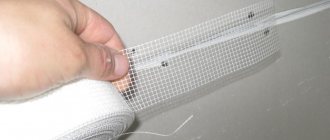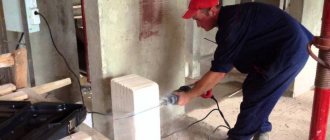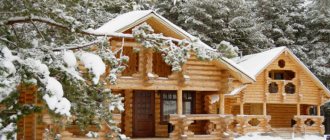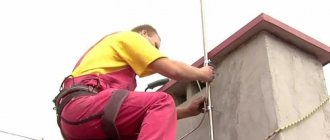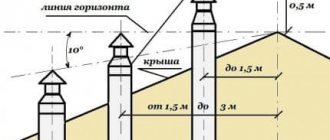Using all possible space, giving the house originality and significantly reducing heat loss through the roof - these are the tasks that the attic solves. If there is a certain margin of safety at the foundation, in this way you can turn a one-story house into a two-level one. Another attractive thing is that you can build an attic roof with your own hands even without special construction skills. It is important not to make a mistake with the choice of materials and do everything according to the rules.
Windows on a regular floor are located in the walls. In attics there are no or almost no walls. They are replaced by a roof. That’s why windows are made special: they not only must let in sufficient light, but also withstand wind and snow loads, which are much greater on roofs than on walls.
Types of attic structures
Before building an attic, it is important to decide what type of device it will have.
Attics are divided into the following types:
- single-level;
- two-level.
In addition, attic roofs are:
- 1-slope;
- 2-slope;
- broken;
- 4-slope;
- hip;
- half-hip;
- with a balcony.
The simplest to install are single-pitched roofs , since they do not have a ridge. In such a roof, the walls have different heights, due to which a bevel is formed; its angle should be in the range from 35 to 45 degrees. 1-slope types are the cheapest.
2-slope - this is the most popular option; it has many different types of designs.
At low financial costs, you can create the required area of the room. Double-pitched roofs can be symmetrical, when the ridge is located strictly in the middle of the building, or asymmetrical, in which case the ridge is shifted from the center.
The gable attic has straight gables, the room is shaped like a trapezoid. Sloping roofs also have two slopes, but their design is much more complicated.
What materials are used to complete the attic?
To build any type of attic, you will need the following building materials:
- wooden bars, most often used with a cross-section of 50x80 millimeters, to create a rafter structure;
- boards from which the sheathing will be made;
- wall panels or other material used for cladding gables
- fasteners, such as: metal corners, screws, nails, metal profiles;
- thermal insulation material;
- vapor barrier;
- waterproofing;
- roofing material;
- interior finishing materials.
The type of materials depends on the preferences of the home owner, and the amount of building materials is influenced by the size of the attic space.
How to move rafters beyond the wall line
The rafters extend beyond the line of the outer wall in order to increase the attic living space. The peculiarity of this method is that the support of the lower rafter beam is the floor board, and not the Mauerlat board.
In this case, reinforcing struts are installed under the extreme part of the triangular sides.
In this case, it is not always advisable to install a Mauerlat, but concrete pouring is necessary , since the floor beams will be attached to the concrete with anchors.
When the rafters are moved beyond the outer line, a cornice should be formed, the width of which for houses made of wood should be at least half a meter, for structures made of stone or concrete - at least 400 centimeters.
Removing the rafters beyond the line of the external wall must be done in the following sequence:
- Install external covering beams with a cross-section of at least 15*20 cm. They serve as the outline of the overhangs and should form a rectangle (based on their roof shape);
- Pull the cord between the outer beams and install the remaining beams in increments of 0.6 m (for a warm room);
- Measure the distance from the left to the right edge, which should correspond to the short leg of the triangle, and mark the points by cutting out the sockets for installing the outer supports;
- Make supports according to the size of the nests from 10*15 cm timber. The length of the support boards should be more than 10 cm;
- Install temporary spacers for mounting corner posts;
- Using a plumb line on a string attached to the posts, check the uniformity of the sampling points for the supports;
- Mount two supports in the central part of the attic gables ;
- Install the purlins on the supports , firmly attaching them with corners;
- Connect the opposite supports with bars , and also attach them to the purlins using corners. Install a temporary support under each beam;
- The beam, which serves as a crossbar, is temporarily fastened with an inch at a distance of 200-300 mm from the edge. To make it convenient to mount the top of the rafter structure, install temporary plank flooring;
- Templates should be made from edged boards , according to which opposite trusses are then mounted:
- The template is made by applying the blank to the beam and the end of the purlin, and corresponds to the rafters of the lower row . Mark the groove lines to size to eliminate excess;
- Install the rafter legs from the end and then from the lower level of the attic;
- Next, use the template to install the upper part of the rafter frame;
- To avoid sagging of the crossbars, it is necessary to attach the headstocks to the trusses from below - in a hinged way, and from above - with a rigid fastening .
The rafter boards are attached to the walls using wire ties and the gable frame is installed.
Removing the rafters from the wall
How to calculate whether an old house can withstand an attic
Before starting to build a new attic structure, it is important to correctly calculate its weight, because not every old house can withstand the additional load.
To calculate the mass of the attic, calculate how much all the components used for its construction weigh:
- rafters;
- sheathing;
- Decoration Materials;
- insulation;
- roofing material.
Log and aerated concrete houses can withstand a maximum load of 600 kilograms per square meter, for cinder block this figure is 1200 kg/m2, and for solid brick 1800 kg/m2.
If, after performing calculations, it was determined that the building will not support the weight of the attic, it is necessary to either lighten it or strengthen the foundation.
What are the components of the price of adding an attic to an old house?
In order to correctly calculate the cost of building an attic, it is important to consider what building materials will be used and what dimensions the building will have.
The first step is to take accurate measurements, after which the following is calculated:
- length and width of the rafter system;
- attic height;
- skate length;
- rafter section;
- number of rafters;
- area of the attic room;
- the total number of rows of sheathing, the number of boards required for it;
- the amount of roofing materials, such as waterproofing and vapor barrier;
- roofing material area;
- volume of insulation material;
- the number of square meters of gable cladding material;
- the length of the boards that will be laid on the attic floor;
- window size.
This is a list of the main materials that will be used for the construction. Depending on the situation, other building materials may be required.
How to make an attic on an old house
Removing the roof is the first stage. Before starting to build an attic, the first step is to dismantle the old roof.
Some people think that you can do without this process, but dismantling the old roof provides double benefits:
- the attic space will be reliable and will not leak;
- Saves money on repairing an old roof.
Dismantling work begins with the removal of roofing material, such as slate, tiles or other covering. It is important to carry out dismantling carefully and slowly.
You should not throw roofing material from a height; it is advisable to lower it carefully, because if there is no damage on it, then it will be used in the future when covering the attic.
When the roof is removed, they begin to remove the roofing felt, if any, it is usually placed as waterproofing. Then the sheathing is dismantled. If the planks are in good condition, they are suitable for creating a new roof sheathing.
After complete removal of the roofing materials, they begin to dismantle the old rafter system, if its height does not allow for an attic, or if the bars are unsuitable for further use.
It takes two or three people to dismantle heavy wooden beams; this work is difficult to handle alone.
The beams and rafter system begin to be disassembled from the ridge.
Interesting attic room design options
The attic can be made cozy by symmetrically arranging sofas on both sides
You can place a long sofa in the attic
In the attic you can create a place to relax by hanging a hammock
In the attic you can make not only a living space, but also a bathroom
You can even make a kitchen on the attic floor
If there is no possibility to place a hammock on the territory, then this can be done on the attic floor
One part of the attic can be completely glazed
The attic can be a great place to create a home library
The walls of the attic can be faced with bricks
You can create a full-fledged living room in the attic
On the attic floor you can arrange a relaxation room
If the house is located in a beautiful area, then the roof can be made panoramic
The bed can be positioned facing the window
In the attic you can make a bedroom with high ceilings
In the attic you can place a hanging chair. This will make the roof more comfortable
Attic design elements
Each attic has its own structural elements, however, in general, the attic space consists of the following elements:
- Mauerlat. These are wooden beams, they are laid along the perimeter of the walls, and then secured to the walls with reliable fasteners. It is to the Mauerlat that the rafter system is attached.
- Rafters are stiffening ribs; they are set at a certain angle.
- The ridge purlin is the top of the rafters.
- The sheathing is made of wooden boards; insulation materials and roofing material are fixed to the sheathing.
- Diagonal ties are used to give the attic additional strength; these ties connect rafters, posts and beams.
- Supports installed inside the attic make the structure more stable, especially when the attic area is large. Internal supports are used as supports for rafters and ridge girders.
- Insulating materials, including sound insulation, insulation, vapor and waterproofing.
Types of rafter systems
The main types of rafter systems for attic construction are presented in two options:
- gable;
- broken rafter system.
Photo gallery: what is an attic
A sloping roof allows you to obtain the optimal combination of roof slope and usable area under it
It is possible to increase the volume of the attic in a structure under a gable roof only due to the high height of the ridge
The attic can be “equipped” with an external structure with a balcony under a separate roof
The balcony can be an integral part of the attic roof structure
However, in practice, the roofs of a country house are so diverse that it is almost impossible to classify them. The design uses a variety of elements:
- hip bevels;
- birdhouses;
- awnings;
- semi-built-in translucent structures (greenhouses);
- lanterns and other architectural solutions in the most original and sometimes unexpected combinations.
Photo gallery: projects of houses with a gable roof and an attic
A gable roof can be decorated with an elegant “birdhouse”, which will also increase the area of the attic
In large houses, a gable structure can be used as one of the elements of the roof composition
The main idea of such a house is to combine simplicity of execution with perfectly selected finishing elements
The procedure for performing installation work
The first step is to install the Mauerlat, these are wooden blocks that are located horizontally, they are placed on top of the walls, rafters and other load-bearing elements are attached to them.
Mauerlat allows you to evenly distribute the load along the entire length of the walls.
To secure the Mauerlat, you will need the following tools, materials and devices:
- wood saw, hammer;
- drill;
- anchor;
- roulette, level.
For the Mauerlat, wood blocks are most often used, the dimensions of which are 150x100 millimeters.
A mauerlat is installed along the perimeter of the walls; these wooden blocks are connected to the walls using mounting dowels.
After installing the Mauerlat, load-bearing beams are attached to it. Then vertical posts are attached to them with self-tapping screws or nails, and the posts are connected to each other from above with beams. Rafters made from wooden blocks are installed on these beams.
For rafters, bars are most often used, the dimensions of which are 50x180 millimeters. Their length depends on the slope of the bevel and the size of the house.
The rafters must be built rigidly; they are the frame that carries almost the entire load of the attic. To ensure that all the rafters are at the same angle, experts recommend first making a template that is applied to the bars being knocked down.
It is advisable to make rafters at an angle of 45-60 degrees. If you reduce this angle, this will significantly reduce the living space of the attic. And if you increase this angle by more than 60 degrees, then the attic will become vulnerable to gusts of wind.
After preparing the frame, it is important to determine what material will be used as the sheathing. The vapor barrier, waterproofing material and roofing will be attached to the sheathing.
If a soft roof is used, then OSB boards must be installed on the wooden frame.
And if the roofing is slate, corrugated sheets, tiles or any other material, wooden planks are used for the sheathing, their dimensions are 40x60 millimeters.
Let's watch a video on how to make an attic on an old house:
Do-it-yourself mansard roof: drawings and construction stages
A house with an attic is not only an additional living space, but also a respectable appearance for the entire building. Even if the room under the roof is made unheated and is used only in the summer, it still creates a powerful “air cushion” that helps retain heat inside the entire building.
DIY mansard roof
In principle, a mansard roof can be built with your own hands, but only with the help of an experienced, knowledgeable craftsman, since it is a rather complex and massive structure.
The attic space can be arranged under different types of roofs, but the most popular are gable or broken structures. According to their structure, they differ somewhat from each other.
To decide which design is more suitable for a particular home and will be easier to install, you need to take a closer look at both of these most commonly used options.
In addition, the master who will build the attic must figure out which of the two existing types of rafter system structures to choose.
Types of rafter systems
Any roof belongs to one of two types of rafter systems - hanging and layered structures. Each of them has its own characteristics, and which one to choose will depend on how the load-bearing walls of the building are located.
Hanging structure
A hanging structure is a rafter system that rests only on the outer main walls. This happens when in the building itself, except for the external walls of the house, there are no more capital partitions.
Diagram of a hanging rafter system
This design can only be used if the distance between the two main walls is no more than 8 meters, since this system puts a large load on the foundation of the load-bearing walls.
To ease this load, various elements are used in the hanging system, such as headstocks and tie rods, crossbars and struts.
For example, struts, as it were, pull the floor beams to the rafter legs, and the headstock hangs the tie to the ridge connection.
In the hanging system, fairly thick bars or hewn logs are used for floor beams, mounted on an edge. Their cross-section must be at least 100 × 200 mm. In order not to make mistakes in the parameters, since the floor in the attic room must be very reliable, it is recommended to entrust the calculations to a specialist.
Are you building a mansard roof with your own hands?
We recommend that you familiarize yourself with the material about how to make rafters with your own hands; in addition, you need to read how rafters are calculated.
In addition, we recommend reading the article about how to calculate the angle of roof inclination.
Layered system
Unlike a hanging system, a layered system is supported not only on two external load-bearing walls, but also on permanent partitions that are installed on the foundation. Therefore, when planning the construction of an attic, you need to think through the design of the foundation in advance if you are installing a strip version on which permanent partitions will be built. The layered system is ideal for constructing an attic underneath, as it can withstand significantly greater loads than the hanging version. It provides a reliable basis for the floor beams, and therefore for the attic floor.
The layered system has additional support on capital partitions
If you build a broken version of the attic roof, then a combined roofing system can be used, i.e. ridge rafters are arranged in the form of a hanging system, and side rafters are arranged in a layered type.
Types of roofs with attic space
When building a house made of brick or blocks with an attic, very often its front side is immediately built from the same material. This is very convenient because you don’t have to calculate the parameters of these roof elements and assemble them from bars, and then lift them onto the wall. However, one must remember that the walls of the building must stand on a reliable foundation and have the proper thickness, since such a pediment puts a very large load on the main structure.
House with a gable mansard roof
If the attic will serve as another floor of the house all year round, then a gable wall made of brick or foam blocks is an ideal option for creating a living space under the roof.
In order for attic rooms with a gable roof to have a normal height and spacious rooms, the angle of the roof slopes should be approximately 45-50 degrees, depending on the width of the end part of the building. If you take a smaller angle, the usable volume of the room will significantly decrease. Increasing the steepness of the slopes will lead to an unreasonably high roof, its weight, greater windage under strong wind loads, and waste of materials.
Dependence of the dimensions of the attic on the angle of the gable roof
Installation of a gable roof is certainly simpler than a broken structure, since smooth rafters are used from the edge of the walls to the ridge, without any kinks or additional connections. However, the broken structure makes it possible to make the rooms in this part of the house more spacious and the ceilings higher.
Broken roof truss system
The broken rafter system is much more complex in calculations, execution, and roofing, but it not only creates a more spacious space under the roof, but also gives the entire structure solidity.
The complexity of a broken system lies in the large number of rather complex connecting nodes. All connections must be made in accordance with existing rules - only in this case will the roof be built stable and reliable.
With a broken system - a large number of complex connections of parts
If the walls are built of stone or brick, then, as in the first version of the attic, the front parts can be laid out in advance, during the general laying process. In this case, in order to create a rafter system, all that remains is to align the finished gables with installing intermediate rafters and supporting fastenings to them.
Video: rafter system for an attic sloping roof
Before purchasing and preparing material for any of the presented systems, it is necessary to draw up a design project with dimensions - it will become the main guiding document for the preparation and assembly of all elements during the installation process.
Attaching the rafters to the mauerlat
In order for the article about the gable roof to remain a multiple of step-by-step instructions, we have included step-by-step information on attaching rafters to the Mauerlat into a separate step-by-step technology - a link to the material.
Read about how to cover a roof with corrugated sheeting on our portal.
Attic project
When drawing up a diagram for the construction of an attic, it is best to do this in different projections in order to see and understand the placement of all elements of the rafter system. It is very important to correctly calculate the height of the roof ridge, since the size of the area under it will directly depend on it.
The height of the racks and the length of the ties will determine the height and width of the residential attic space
When drawing up a design diagram for the construction of an attic roof, you need to calculate the height of the ridge, ceiling and total area of the room.
The minimum height from the floor to the ridge should be 2.5-2.7 m, but if this distance is less, then the room is not an attic, it can only be called an attic. This parameter is established by SNIP standards.
Possible dimensions for a gable mansard roof
In order for all the elements to be drawn accurately and have the desired location in the overall system, you need to start from a figure with right angles, that is, a rectangle or square - a section of the attic room being created. Based on the sides (the height and width of the future room), it will be almost impossible to make a mistake with the angles at which the roof slopes are located, with the location of the ridge, rafters and all supporting elements. When determining these parameters, they must immediately be entered into the drawing.
First you need to find the middle of the width of the front wall. Starting from this point, the parameters of the height of the ridge, the future ceiling of the attic, the location of the wall studs and the size of the eaves overhang are determined.
Due to the fact that each of the structures has a certain number of connecting nodes, which have different configurations, it would be a good idea to draw each of these connections separately in order to understand their features of interconnecting all the elements connecting at this point.
The main elements of the attic roof rafter system
Any rafter system consists of basic elements and additional ones, which may not be present in every structure. The main components of an attic roof include:
- Floor beams, which are the basis for the remaining elements of the rafter system. They are laid on the main walls of the building.
- A rafter leg, straight in a gable roof system or consisting of two sections - in a broken pattern. In this case, the top rafter is called the ridge rafter, since it forms the highest point of the roof - the ridge, and the rafters that form the walls of the attic are called side rafters.
- A ridge board or beam is a mandatory element for a gable roof, but is not always used when installing a broken roof model.
- Mauerlat is a powerful beam attached to the main side walls of the building. Rafter legs are installed on this element.
- Racks are the supporting elements necessary to strengthen a gable and broken structure. In the latter case, the ridge and side rafters are attached to it, and in the first, the stand is a reliable support for a long rafter. In addition, the racks serve as a frame for insulating and covering the walls of the attic.
- Diagonal bracing members or bevels additionally secure posts or longitudinal beams and rafters, making the structure more durable.
- Attic floor beams are used in all versions of the attic - they connect the racks, and they also serve as the frame for the ceiling.
- Inter-rafter purlins are installed in a broken roof for structural rigidity.
To be sure that the prepared project has been developed correctly, you need to show it to a specialist. Only he will be able to determine whether the attic parameters are correctly selected for the width and length of the walls of the building.
Video: professional calculation of a mansard roof using special software
Material parameters for the construction of an attic roof
If the graphic design is ready, then, based on the dimensions marked on it, you can calculate the amount of materials required for the construction of the attic roof. Materials must be selected according to their characteristics, which must meet fire and environmental safety requirements. For wood, it is necessary to provide special treatment with fire retardants, which will reduce the flammability of the material. So, for construction you will need:
- Boards for rafter legs. Their cross section is selected based on the results of special calculations - this will be discussed in more detail below.
- A beam having a cross-section of 100×150 or 150×200 mm is for floor beams, depending on the chosen rafter system and the width between the load-bearing walls, as well as for purlins, diagonal legs or valleys - if they are provided for in the design.
- Beam with a cross section of 100×150 mm or 150×150 mm for laying the Mauerlat.
- For racks, timber 100 × 100 or 150 × 150 mm is usually used.
- Unedged board for laying the subfloor and some fasteners.
- Annealed steel wire with a diameter of 3-4 mm - for fastening some parts together.
- Nails, bolts, staples of various sizes, angles of various configurations and other fasteners.
- A metal sheet with a thickness of at least 1 mm is for cutting out overlays.
- Lumber for sheathing and counter-lattens for roofing material - depending on the type of roof chosen.
- Insulation materials – for thermal insulation of the roof.
- Waterproofing and vapor barrier membranes.
- Roofing material and fastening elements for it.
What section of rafters are required?
Rafters are roofing elements that will bear the main external loads, so the requirements for their cross-section are quite special.
The size of the required lumber will depend on many parameters - on the step between the rafter legs, on the length of these legs between the support points, on the snow and wind load that falls on them.
The geometric parameters of the rafter system design are easy to determine in the drawing. But with the remaining parameters, you will have to refer to the reference material and make some calculations.
Snow load
Snow load is not the same for different regions of our country. The figure below shows a map on which the entire territory of Russia is divided into zones according to the intensity of the snow load.
Map of calculated snow loads on the territory of the Russian Federation
There are eight such zones in total (the last, eighth, is rather extreme and cannot be considered for the construction of an attic roof).
| Zoning by snow load | Value in kPa | Value in kg/m² |
| I | 0.8 kPa | 80 kg/m² |
| II | 1.2 kPa | 120 kg/m² |
| III | 1.8 kPa | 180 kg/m² |
| IV | 2.4 kPa | 240 kg/m² |
| V | 3.2 kPa | 320 kg/m² |
| VI | 4.0 kPa | 400 kg/m² |
| VII | 4.8 kPa | 480 kg/m² |
Now you can accurately determine the snow load, which will depend on the angle of the roof slope. For this there is the following formula:
S = Sg × μ
Sg – table value - see the map and the table attached to it
μ is a correction factor depending on the steepness of the roof slope.
- If the slope angle is less than 25°, then μ=1.0
- With a slope from 25 to 60° - μ=0.7
- If the roof is steeper than 60°, then it is considered that snow does not linger on it, and the snow load is not taken into account at all.
It is typical that if the attic roof has a broken structure, then for different sections of it the load can have different values.
The slope angle of the roof can be easily estimated from the ratio of the height of the ridge and the width of the span
The slope angle of the roof can always be determined either with a protractor - according to the drawing, or by a simple ratio of the height and base of the triangle (usually half the width of the span):
| Ratio of slope height to projected width (H/L) | Approximate slope angle (α) |
| 0.27 | 15° |
| 0.36 | 20° |
| 0.47 | 25° |
| 0.58 | 30° |
| 0.7 | 35° |
| 0.84 | 40° |
| 1 | 45° |
| 1.2 | 50° |
| 1.4 | 55° |
| 1.73 | 60° |
| 2.14 | 65° |
Wind load
Wind load also mainly depends on the region in which the building was built and on the characteristics of its surroundings and the height of the roof.
Zoning of the territory of the Russian Federation according to the average level of wind load
And again, for the calculation, the initial data on the map and the table attached to it are first determined:
| Zoning of wind load in Russia | 1a | 1 | 2 | 3 | 4 | 5 | 6 | 7 |
| Table value of wind pressure, kg/m² (W) | 24 | 32 | 42 | 53 | 67 | 84 | 100 | 120 |
The calculation for a specific building will be carried out according to the formula:
Wp = W × k × c
W – table value, depending on the region
k – coefficient taking into account the height of the building and its location (see table)
| Building height (z) | Zone A | Zone B | Zone B |
| no more than 5 m | 0.75 | 0.5 | 0.4 |
| from 5 to 10 m | 1 | 0.65 | 0.4 |
| from 10 to 20 m | 1.25 | 0.85 | 0.55 |
The following zones are indicated by letters in the table:
- zone A - open areas, steppes, forest-steppes, deserts, tundra or forest-tundra, wind-exposed sea coasts, large lakes and reservoirs.
- zone B – urban areas, wooded areas, areas with frequent wind obstacles, relief or artificial, at least 10 meters high.
- zone B – dense urban development with an average building height above 25 meters.
с – coefficient depending on the predominant wind direction (wind rose of the region) and on the angle of inclination of the roof slopes.
With this coefficient the situation is somewhat more complicated, since the wind can have a dual effect on the roof slopes. So, it has a direct, overturning effect directly on the roof slopes. But at small angles, the aerodynamic effect of the wind takes on special importance - it tries to raise the slope plane due to the resulting lift forces.
Diagrams and tables of wind load distribution by roof sections
The drawings, diagrams and accompanying tables indicate areas of the roof exposed to maximum wind loads and indicate the corresponding coefficients for calculation.
It is characteristic that at slope angles of up to 30 degrees (and this is quite possible in the area of ridge rafters), the coefficients are indicated both with a plus sign and negative, that is, directed upward. They somewhat dampen the frontal wind load (this is taken into account in the calculations), and in order to neutralize the effect of lifting forces, it will be necessary to very carefully secure the rafter system and roofing material in this area, using additional connections, for example, using annealed steel wire.
Once the wind and snow loads have been calculated, they can be summed up and, taking into account the design features of the system being created, the cross-section of the rafter boards can be determined.
Please note that the data is given for the most commonly used coniferous material (pine, spruce, cedar or larch). The table shows the maximum length of the rafters between the support points, the section of the board depending on the grade of the material, and on the pitch between the rafters.
The value of the total load is indicated in kPa (Kilopascals). Converting this value into more familiar kilograms per square meter is not difficult. With quite acceptable rounding, we can accept: 1 kPa ≈ 100 kg/m² .
The dimensions of the board along its cross-section are rounded up to standard lumber sizes.
| rafter section (mm) | Distance between adjacent rafters (mm) | ||||||
| 300 | 600 | 900 | 300 | 600 | 900 | ||
| total snow and wind load | 1.0 kPa | 1.5 kPa | |||||
| higher | 40×89 | 3.22 | 2.92 | 2.55 | 2.81 | 2.55 | 2.23 |
| 40×140 | 5.06 | 4.60 | 4.02 | 4.42 | 4.02 | 3.54 | |
| 50×184 | 6.65 | 6.05 | 5.28 | 5.81 | 5.28 | 4.61 | |
| 50×235 | 8.50 | 7.72 | 6.74 | 7.42 | 6.74 | 5.89 | |
| 50×286 | 10.34 | 9.40 | 8.21 | 9.03 | 8.21 | 7.17 | |
| 1 or 2 | 40×89 | 3.11 | 2.83 | 2.47 | 2.72 | 2.47 | 2.16 |
| 40×140 | 4.90 | 4.45 | 3.89 | 4.28 | 3.89 | 3.40 | |
| 50×184 | 6.44 | 5.85 | 5.11 | 5.62 | 5.11 | 4.41 | |
| 50×235 | 8.22 | 7.47 | 6.50 | 7.18 | 6.52 | 5.39 | |
| 50×286 | 10.00 | 9.06 | 7.40 | 8.74 | 7.66 | 6.25 | |
| 3 | 40×89 | 3.06 | 2.78 | 2.31 | 2.67 | 2.39 | 1.95 |
| 40×140 | 4.67 | 4.04 | 3.30 | 3.95 | 3.42 | 2.79 | |
| 50×184 | 5.68 | 4.92 | 4.02 | 4.80 | 4.16 | 3.40 | |
| 50×235 | 6.95 | 6.02 | 4.91 | 5.87 | 5.08 | 4.15 | |
| 50×286 | 8.06 | 6.98 | 6.70 | 6.81 | 5.90 | 4.82 | |
| total snow and wind load | 2.0 kPa | 2.5 kPa | |||||
| higher | 40×89 | 4.02 | 3.65 | 3.19 | 3.73 | 3.39 | 2.96 |
| 40×140 | 5.28 | 4.80 | 4.19 | 4.90 | 4.45 | 3.89 | |
| 50×184 | 6.74 | 6.13 | 5.35 | 6.26 | 5.69 | 4.97 | |
| 50×235 | 8.21 | 7.46 | 6.52 | 7.62 | 6.92 | 5.90 | |
| 50×286 | 2.47 | 2.24 | 1.96 | 2.29 | 2.08 | 1.82 | |
| 1 or 2 | 40×89 | 3.89 | 3.53 | 3.08 | 3.61 | 3.28 | 2.86 |
| 40×140 | 5.11 | 4.64 | 3.89 | 4.74 | 4.31 | 3.52 | |
| 50×184 | 6.52 | 5.82 | 4.75 | 6.06 | 5.27 | 4.30 | |
| 50×235 | 7.80 | 6.76 | 5.52 | 7.06 | 6.11 | 4.99 | |
| 50×286 | 2.43 | 2.11 | 1.72 | 2.21 | 1.91 | 1.56 | |
| 3 | 40×89 | 3.48 | 3.01 | 2.46 | 3.15 | 2.73 | 2.23 |
| 40×140 | 4.23 | 3.67 | 2.99 | 3.83 | 3.32 | 2.71 | |
| 50×184 | 5.18 | 4.48 | 3.66 | 4.68 | 4.06 | 3.31 | |
| 50×235 | 6.01 | 5.20 | 4.25 | 5.43 | 4.71 | 3.84 | |
| 50×286 | 6.52 | 5.82 | 4.75 | 6.06 | 5.27 | 4.30 | |
Tools
Naturally, during work you cannot do without tools, the list of which includes:
- Electric drill, screwdriver.
- Building level and plumb line, tape measure, square.
- Axe, chisel, chisel, hammer
- Circular saw, jigsaw, hacksaw.
- Carpenter's knife.
Installation will be accelerated if the tools for the work are of high quality, and the work will be carried out with competent mentors and assistants, carefully and step by step.
Installation stages
It is necessary to strictly follow the sequence of work - only under this condition the structure will be reliable and durable.
Mounting the Mauerlat
The installation of any rafter system begins with attaching a powerful support beam - a mauerlat - to the end of the side walls of the structure, on which it will be convenient to install the rafter legs. The Mauerlat is made from high-quality timber with a cross-section of at least 100 × 150 mm. It must be laid on roofing felt waterproofing laid along the upper end of the wall (regardless of the material).
Due to the Mauerlat, the load will be evenly distributed over the walls and transferred to the foundation of the building.
One of the options for attaching the Mauerlat to the walls of the house
The Mauerlat is secured to the wall using metal pins, which are pre-embedded in a concrete belt or crown running along the upper edge of the wall, or with anchor bolts with a diameter of 12 mm. They must go into the wall at least 150 - 170 mm. If the Mauerlat is installed on a wooden wall, then the beams are attached to it using wooden dowels.
Installation of truss structure
- Installation of the rafter system begins with the installation of floor beams. They can be mounted on the Mauerlat from above if the beams are planned to be moved outside the perimeter of the building and thereby increase the area of the attic. In this design, the rafter legs are fixed to the floor beams.
Floor beams fixed on top of the Mauerlat (Fig. A)
- In another case, they can be laid on waterproofed walls and attached using corners or brackets to the inner edge of the Mauerlat. This option is used when the rafter legs are planned to be attached directly to the mauerlat.
Another option is that only the rafter legs are attached to the Mauerlat
- Next, you need to find the middle of the floor beam, since this mark will become a guideline for determining the location of the support posts and the ridge.
- The posts should be located at the same distance from the marked center of the floor beam. They will subsequently determine the location of the walls of the attic room, that is, its width.
- The bars for the racks must have a cross-section equal to the size of the floor beams. The constructions are attached to the beams using special corners and wooden overlays. However, to begin with, they are first nailed, then carefully leveled using a building level and a plumb line, and only then are they permanently secured, taking into account future loads.
Installation of racks and ties connecting them
- When the first pair of racks is installed, they are fastened together from above with a bar, which is called a tie. This tightening is also connected to the racks using special metal corners.
Shaped metal corners for reliable fastening of rafter system parts
- After securing the tie, you will get a U-shaped structure. Layered rafters are installed on its sides, the second end of which is attached to the floor beam or placed on the mauerlat.
- A special recess (groove) is cut into the installed supports for the timber or in the rafters. With its use, the rafters are tightly installed on the mauerlat beam, and secured with metal brackets.
Fastening the rafter leg to the mauerlat with a bracket
- To provide rigidity to the structure, additional struts can be installed from the base of the rack to the middle of the installed side rafters. If this does not seem enough, and saving material is not in the foreground, then you can strengthen the overall structure with additional racks and contractions (they are indicated in the drawing, Fig. A, with translucent lines).
- Next, while tightening, the middle is calculated - the headstock will be attached to this place, supporting the ridge connection of the upper hanging subsystem of the rafters.
- The next step is to install the ridge rafters, which can be fastened together with various connections - this can be a metal plate or powerful bolts with metal plates or washers.
Interconnection of rafter legs in the ridge area
- After installing them, the headstock is attached to the ridge and the middle of the tightening.
- Having completed work on one part of the rafter system, you need to make all the rest according to the same principle. The distance between adjacent rafters in such a system should be no more than 900 - 950 mm, but the optimal interval would probably still be 600 mm - this will provide the necessary rigidity and stability of the structure, and will be convenient for insulation using standard mineral wool mats . True, this makes the structure heavier and will require more materials.
Installation is carried out gradually, with the installation and tying of rafter pairs.
- First, the side parts of the system assembly are installed, and then the intermediate parts. They are connected to each other by purlins, which are installed between the upper ends of the racks and act as spacers. Thus, you will get a rigid structure of the attic rafters, in which the frame for wall cladding will already be ready.
Prices for various types of fasteners for rafters
Rafter fasteners
Waterproofing attic roof
When the rafter system is built, you can proceed to finishing it with insulation and related materials.
- The first coating that should be fixed directly on top of the rafters will be a waterproofing and windproof film. it is attached to the rafters using staples and a stapler, starting from the cornice. The canvases are overlapped by 150 - 200 mm, and then the joints are glued together with waterproof tape.
- On top of the waterproofing, a counter-lattice is placed on the rafters, which will more reliably fix the film on the surface and create the necessary ventilation distance between the windproof and roofing material. The counter-lattice is usually made of boards 100 - 150 mm wide and 50 - 70 mm thick.
Waterproofing and windproof film, lathing and counter lathing on the roof surface
- The sheathing is fixed perpendicular to the counter-lattice, on which the roofing material will then be laid. The pitch between the slats must be calculated depending on the type and size of the sheet roofing material, taking into account the overlap required for it
- If a soft roof is chosen, then plywood sheets are most often fixed to the counter-lattice.
Roofing installation
The roofing material is attached to the prepared sheathing or plywood. Its installation usually starts from the roof eaves and proceeds in rows, from one of the edges - depending on the type of roof. Roofing sheets are mounted with an overlap. If a metal profile or metal tile is used for the coating, then such material is secured with special self-tapping screws with elastic gaskets. Fastening elements are usually matched in color to the roofing material.
The creation of a mansard roof is completed by laying roofing material
The most difficult thing in covering an attic sloping roof is the transition from layered side rafters to hanging ridge rafters. There may be certain difficulties if the roof has projections for installing roofs over balconies or windows.
In addition, if a chimney pipe goes onto the roof, it requires a separate design of the hole inside the rafter system and an insulating layer, and on the roof - reliable waterproofing around the pipe.
You can find out in detail how and what is the best way to cover a roof on our portal; there is a whole section “roof and roofing” , in which you can find answers to many questions, including recommendations for reliable insulation of an attic room.
Prices for popular types of corrugated sheets
Corrugated sheet
Video: detailed video tutorial on building a mansard roof
It should be noted that the work of constructing any roof, and especially one as complex as an attic roof, is not only responsible, but also quite dangerous and requires special, increased safety measures. If you have no experience in carrying out such construction processes, then it is better to entrust their implementation to professionals or perform all actions under the supervision of an experienced craftsman, and with the utmost care and precision.
Waterproofing and insulation
Waterproofing material and thermal insulation are installed because warm air rising from the attic space can cause serious damage to the ceiling and rafters, over time it will destroy the wood.
To avoid this, waterproofing is installed during the construction of the attic. Insulation helps keep the room warm.
Waterproofing materials are made in the form of film or roll material, they are mounted on the sheathing.
Waterproofing can also be rolled, coated, sprayed or liquid. The waterproofing material is the substrate for the roof. The following is used as thermal insulation:
- mineral wool;
- fiberglass;
- expanded polystyrene;
- extruded polystyrene foam boards;
- penoizol;
- bulk materials.
The most common material for thermal insulation is mineral wool; it is simple and easy to install, is non-flammable, can withstand temperatures up to 800 degrees, has good thermal insulation characteristics and is inexpensive.
Expanded polystyrene is used less frequently because it cannot retain or transmit moisture, and its thermal insulation characteristics are no worse than mineral wool.
Loose insulation is great for a roof that has a lot of unevenness, where wool and polystyrene cannot fit tightly to all curved surfaces.
Thermal insulation with foam insulation is used when special equipment is available. Penoizol penetrates perfectly into any cracks and holes because it has a semi-liquid consistency.
The thermal insulation material must fit tightly to the rafters; there should be no cracks, voids or gaps.
For the heat-insulating layer, the lathing should have a pitch of about 50 centimeters, thanks to which the insulation will be tightly fixed.
Roofing
Roofing materials are mounted on the sheathing.
Most often used as a roof:
- corrugated sheets,
- slate,
- ondulin,
- metal tiles,
- galvanized metal, and others.
The lathing is fixed in increments of 20-80 centimeters, depending on the angle of the roof.
The smaller the angle of inclination, the shorter the pitch of the sheathing will be. Roofing materials are installed starting from the bottom row. This row is fastened slowly, very carefully, so that the bottom line is without protrusions and perfectly smooth. Roofing material must be installed with an overlap.
The roofing material is secured with nails, self-tapping screws or screws, depending on the type of sheets. After installing the entire roof, a ridge is mounted on the top of the rafters.
Interior decoration
All kinds of materials are used for interior decoration of the attic.
The following are used as flooring:
- linoleum;
- laminate;
- ceramic tiles;
- carpet;
- parquet;
- wooden boards;
- cement screed.
Before installing any material, preparatory work is carried out.
For finishing walls and ceilings use:
- plywood;
- OSB boards;
- drywall;
- eurolining;
- slats;
- block house;
- Fiberboard or chipboard.
After installation of any of these materials, finishing is carried out.
It could be:
- putty;
- painting;
- wallpaper sticker;
- wood varnishing;
- textured finish.
Any type of interior finishing is carried out strictly in accordance with technological requirements.
Let's watch another video about building an attic with your own hands:
Recommendations that are better to know at the beginning of the journey
An attic floor with a gable roof is installed using exactly the same principle. Moreover, its structure is even simpler - all rafters are solid.
Next comes insulation of the roof. Of course, it can be done outside, before installing the membrane, sheathing and roof. But it’s safer from the inside - there will be no threat of precipitation and the work will be done more carefully, because successful operation depends on this.
The insulation from the inside of the room is protected by a vapor barrier film. And between it and the interior decoration, a ventilation gap is required - the interior decoration is not mounted directly on the rafters. For it, just like outside for sheathing, a counter batten is placed or a frame is arranged.
